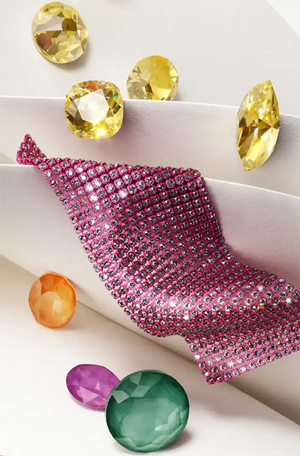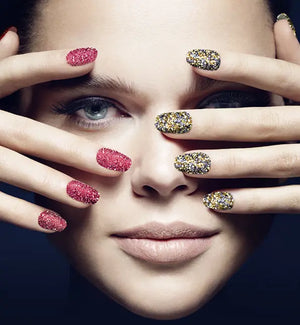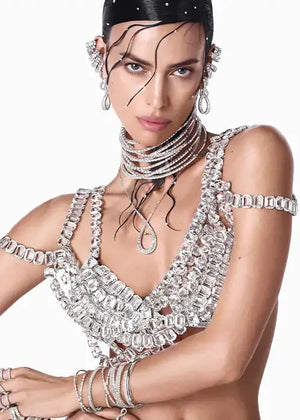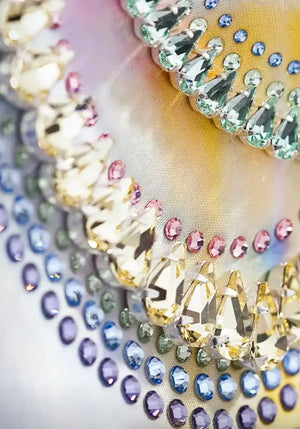
Rhinestones vs Cubic Zirconia: What's the Difference?
Let's be real—when you're staring at a tray of sparkly stuff at the craft store, it's easy to think "shiny is shiny" and call it a day. But if you've ever wondered why some of those twinkly bits cost way more than others, you've stumbled into the rhinestone versus cubic zirconia debate.
The Basic Difference (Without Getting Too Nerdy About It)
Rhinestones are basically fancy glass or plastic with a metallic backing that makes them sparkle. They used to be actual crystals from the Rhine River back in the day (hence the name), but now they're manufactured. Think of them as the glitzy cousins in the crystal family—they're here for a good time, not necessarily a long time.
Cubic zirconia (CZ for short) is trying to be something else entirely—it's the understudy for diamonds. It's made from zirconium dioxide and has an actual crystalline structure, not just a reflective backing. CZs are the ones that make your friends squint and say, "Is that real?" before you smugly tell them what a great deal you got.
How They Look Up Close
This is where things get interesting.
Rhinestones have this flashy, almost rainbow-like sparkle. They're not subtle. At all. They're the jazz hands of the jewelry world—when you move, they practically scream for attention. The quality varies wildly though. I've seen cheap ones that look like plastic in sunlight and premium ones (like Swarovski) that actually make people gasp. If you're curious about the high-end options, check out this comparison of Preciosa and Swarovski crystals—the difference is pretty wild.
Cubic zirconia has a more sophisticated vibe. It's trying to mimic diamonds, so it has that clear, white sparkle rather than the rainbow effect. CZs are actually pretty convincing from a distance—it's only when you get up close or compare them directly to diamonds that you notice they're a bit too... perfect? Diamonds have tiny imperfections, while CZs can look almost too flawless. But hey, for most of us, "too perfect" isn't exactly a complaint.
Durability (Or: Will It Survive More Than One Night Out?)
Here's where cubic zirconia really pulls ahead.
Rhinestones—especially the acrylic ones—can scratch if you look at them wrong. OK, slight exaggeration, but they're definitely the more delicate option. The metallic backing can wear off over time, especially if you're someone who uses hairspray or perfume while wearing them. Glass rhinestones hold up better than plastic ones, but they're still not what I'd call "heirloom quality."
Cubic zirconia is surprisingly tough. It ranks around 8-8.5 on the Mohs hardness scale (diamonds are a 10), which means it can handle everyday wear pretty well. They won't cloud up or yellow over time like some other diamond alternatives. That said, they can chip if you smack them hard enough against something—they're not invincible.
Price Tags
Rhinestones = budget-friendly. We're talking anywhere from dirt cheap for the basic craft store variety to maybe a few dollars each for the fancy-pants Swarovski ones. They're perfect for those projects where you need a LOT of sparkle without emptying your wallet.
Cubic zirconia costs more than rhinestones but waaaaay less than diamonds. A decent-sized CZ might run you $5-$50 depending on quality and size. For perspective, a diamond of similar size could be thousands. So yeah, there's that.
Rhinestones vs Cubic Zirconia: When To Use Which
Rhinestones are your go-to for:
- That Halloween costume where you need to be "extra"
- Dance recital outfits (they literally shine under stage lights)
- Bedazzling literally anything (phone cases, jean pockets, whatever)
- Projects where you need hundreds of sparkly bits
Cubic zirconia makes more sense for:
- Jewelry you'll wear to work or nice events
- Pieces you want people to maybe-possibly think are "real"
- Things you don't want to replace next month
- Wedding stuff (when the budget doesn't allow for diamonds)
The Bottom Line
There's no "winner" here—just different tools for different jobs. It's like comparing a glitter pen to a fine-point Montblanc. Both make marks on paper, but you wouldn't use them for the same thing.
For crafters and designers looking for high-quality embellishments, having both in your arsenal makes sense. Use rhinestones when you want that in-your-face sparkle and CZ when you're going for that "is it real?" elegance.
And honestly? Sometimes mixing both in one project gives you the best of both worlds—the flash AND the class. Because who says you have to choose just one type of sparkle in your life?







